
The Royal Navy (RN) is the United Kingdom's naval warfare force and a component of His Majesty's Naval Service. Although warships were used by English and Scottish kings from the early medieval period, the first major maritime engagements were fought in the Hundred Years' War against France. The modern Royal Navy traces its origins to the early 16th century; the oldest of the UK's armed services, it is consequently known as the Senior Service.

In British maritime law and custom, an ensign is the identifying flag flown to designate a British ship, either military or civilian. Such flags display the United Kingdom Union Flag in the canton, with either a red, white or blue field, dependent on whether the vessel is civilian, naval, or in a special category. These are known as the red, white, and blue ensigns respectively.

The Royal Canadian Navy is the naval force of Canada. The RCN is one of three environmental commands within the Canadian Armed Forces. As of 2023, the RCN operates 12 frigates, four attack submarines, 12 coastal defence vessels, eight patrol-class training vessels, two offshore patrol vessels, and several auxiliary vessels. The RCN consists of 8,400 Regular Force and 4,100 Primary Reserve sailors, supported by 3,800 civilians. Vice-Admiral Angus Topshee is the commander of the Royal Canadian Navy and chief of the Naval Staff.
A midshipman is an officer of the lowest rank, in the Royal Navy, United States Navy, and many Commonwealth navies. Commonwealth countries which use the rank include Canada, Australia, Bangladesh, Namibia, New Zealand, South Africa, India, Pakistan, Singapore, Sri Lanka, and Kenya.
Ensign is a junior rank of a commissioned officer in the armed forces of some countries, normally in the infantry or navy. As the junior officer in an infantry regiment was traditionally the carrier of the ensign flag, the rank acquired the name. This rank has generally been replaced in army ranks by second lieutenant. Ensigns were generally the lowest-ranking commissioned officer, except where the rank of subaltern existed. In contrast, the Arab rank of ensign, لواء, liwa', derives from the command of units with an ensign, not the carrier of such a unit's ensign, and is today the equivalent of a major general.
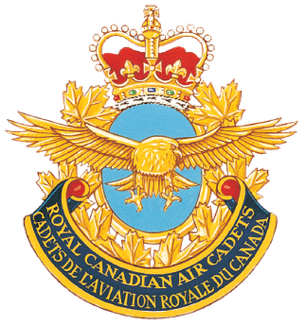
The Royal Canadian Air Cadets is a Canadian national youth program for young individuals aged 12 to 19. Under the authority of the National Defence Act, the program is administered by the Canadian Forces (CF) and funded through the Department of National Defence (DND). Additional support is provided by the civilian Air Cadet League of Canada (ACL). Together with the Royal Canadian Sea Cadets and Royal Canadian Army Cadets, it forms the "largest federally funded youth program in the country". Cadets are not members of the military and are not obliged to join the Canadian Forces.
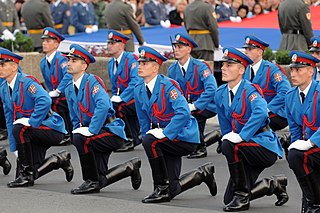
A cadet is an officer trainee or candidate. The term is frequently used to refer to those training to become an officer in the military or maritime sector, often a person who is a junior trainee. Its meaning may vary between countries which can include youths in voluntary youth organisations.
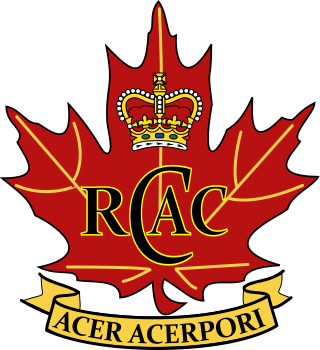
The Royal Canadian Army Cadets is a national Canadian youth program sponsored by the Canadian Armed Forces and the civilian Army Cadet League of Canada. Under the authority of the National Defence Act, the program is administered by the Canadian Armed Forces and funded through the Department of National Defence. Additionally, the civilian partner of the Royal Canadian Army Cadets, the Army Cadet League of Canada, also ensures financial, accommodations and transportation support for RCAC programs and services at a community level.

A cap badge, also known as head badge or hat badge, is a badge worn on uniform headgear and distinguishes the wearer's nationality and/or organisation. The wearing of cap badges is a convention commonly found among military and police forces, as well as uniformed civilian groups such as the Boy Scouts, civil defence organisations, ambulance services, customs services, fire services etc.
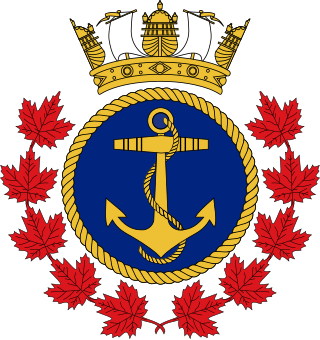
The Royal Canadian Sea Cadets is a Canadian national youth program sponsored by the Canadian Armed Forces and the civilian Navy League of Canada. Administered by the Canadian Forces, the program is funded through the Department of National Defence, with the civilian partner providing support in the local community. Cadets are not members of the Canadian Armed Forces.
The Navy League Cadet Corps was created by the Navy League of Canada for boys in 1948, and the Navy League Wrennette Corps was formed for girls in 1950. The Wrennette program no longer exists, since the Navy League Cadet Corps are now open to boys and girls between the ages of 9 and 12.
The Navy League Wrennette Corps was formed by the Navy League of Canada in 1950 as a cadet organisation for girls to complement the Navy League Cadet Corps of Canada.

The Bermuda Sea Cadet Corps was created as a registered charity under the Bermuda Sea Cadet Association Act, 1968. The first unit had actually been created two years earlier.

Sea cadets are members of a Sea Cadets Corps, a formal uniformed youth organisation for young people with an interest in waterborne activities and or the national navy. The organisation may be sponsored in whole or in part by the navy or a naval supporter's organisation. In the United Kingdom, sea cadets are governed by the parent charity MSSC and receives just over half of its funding from the Ministry of Defence. The Royal Navy is its principal supporter, but it is not a pre-service organisation and works in partnerships with the broader maritime community as well. The various organisations are listed in alphabetical order of their nation.
The Navy League of Australia is an Australian organisation and advocacy group dedicated to creating interest in maritime and naval matters, particularly those relating to the Royal Australian Navy (RAN) and the Australian Merchant Navy.
The Canadian Cadet Organizations, marketed under the name of Cadets Canada, are a youth program known as the Royal Canadian Sea Cadets, Royal Canadian Army Cadets, and Royal Canadian Air Cadets. The program is sponsored by the Canadian Armed Forces and funded through the Department of National Defence (DND), with additional support from the civilian Navy League, the Army Cadet League and the Air Cadet League, as well as local community sponsors that include service organizations and parent sponsoring groups supervised by the Leagues.

Currie Hall is a hall within the Currie Building, which is an annex to the Mackenzie Building at the Royal Military College of Canada in Kingston, Ontario. It was built in 1922, and is a Recognized Federal Heritage Building.

The Army Cadet League of Canada is the civilian non-profit organization which works with the Department of National Defence (DND) to support the Royal Canadian Army Cadet program. It was founded in 1971 with a branch in every province and one for the northern region. The ACLC consists of several levels from the national council to local support committees.
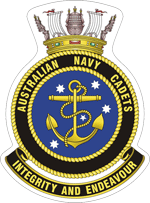
The Australian Navy Cadets (ANC) is a leading national youth development organisation, with the character and values of the Australian Navy, founded on a strong community partnership, fostering and supporting an ongoing interest in the Australian Navy.
RCSCC Calgary is a Royal Canadian Sea Cadet Corps located in Calgary, Alberta, Canada that has trained youth aged 12–18 in the Royal Canadian Sea Cadets program since 1991.


















